
Concept explainers
(a)
Interpretation:
The most polar bond of methanol should be identified and polarity described with symbols
Concept Introduction:
Polarity of any molecule depends on electronegativity of atoms that forms covalent bonds. Depending upon the difference in electronegativity of atoms, polar or nonpolar molecule is determined. Polar molecule has electronegativity between 0.5 and 1.4 whereas in nonpolar molecule, it is less than 0.5.
Answer to Problem 10.49P
In methanol, most polar bond is O-H bond with electronegativity difference of 1.4 and oxygen atom becomes partial negative charge atom whereas hydrogen becomes partial positive charge atom.

Explanation of Solution
Polar covalent bonds contains more atoms with high electronegativity and acquire more partial negative charge represented as delta minus
In methanol, most polar bond is O-H with electronegativity difference of 1.4 and oxygen atom becomes partial negative charge atom whereas hydrogen becomes partial positive charge atom.
C-O bond have 1.0 electronegativity but it is less polar when compare to O-H bond.
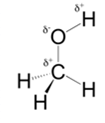
(b)
Interpretation:
The most polar bond of methylamine should be identified and polarity described with symbols
Concept Introduction:
Polarity of any molecule depends on electronegativity of atoms that forms covalent bonds. Depending upon the difference in electronegativity of atoms, polar or nonpolar molecule is determined. Polar molecule has electronegativity between 0.5 and 1.4 whereas in nonpolar molecule, it is less than 0.5.
Answer to Problem 10.49P
In methylamine, most polar bond is N-H bond with electronegativity difference of 0.9 and nitrogen atom becomes partial negative charge atom whereas hydrogen becomes partial positive charge atom.
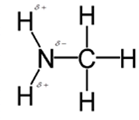
Explanation of Solution
Polar covalent bonds contains more atoms with high electronegativity and acquire more partial negative charge represented as delta minus
In methylamine, most polar bond is N-H with electronegativity difference of 0.9 and nitrogen atom becomes partial negative charge atom whereas hydrogen becomes partial positive charge atom.
C-H bond is nonpolar because of electronegativity of 0.4 only.
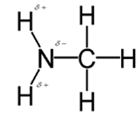
(c)
Interpretation:
The most polar bond of 2-aminoethathiol should be identified and polarity described with symbols
Concept Introduction:
Polarity of any molecule depends on electronegativity of atoms that forms covalent bonds. Depending upon the difference in electronegativity of atoms, polar or nonpolar molecule is determined. Polar molecule has electronegativity between 0.5 and 1.4 whereas in nonpolar molecule, it is less than 0.5.
Answer to Problem 10.49P
In 2-aminoethathiol, most polar bond is N-Hbond with electronegativity difference of 0.9 and nitrogen atom becomes partial negative charge atom whereas hydrogen becomes partial positive charge atom.

Explanation of Solution
Polar covalent bonds contains more atoms with high electronegativity and acquire more partial negative charge represented as delta minus
In 2-aminoethanethiol, most polar bond is N-H with electronegativity difference of 0.9 and nitrogen atom becomes partial negative charge atom whereas hydrogen becomes partial positive charge atom.
The bonds S-H, C-C and C-H have electronegativity difference are 0.4, 0, and 0.4 respectively.

(d)
Interpretation:
The most polar bond of acetone should be identified and polarity described with symbols
Concept Introduction:
Polarity of any molecule depends on electronegativity of atoms that forms covalent bonds. Depending upon the difference in electronegativity of atoms, polar or nonpolar molecule is determined. Polar molecule has electronegativity between 0.5 and 1.4 whereas in nonpolar molecule, it is less than 0.5.
Answer to Problem 10.49P
In acetone, most polar bond is C=O with electronegativity difference of 1.0 and oxygen atom becomes partial negative charge atom whereas carbon becomes partial positive charge atom.
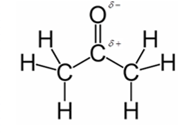
Explanation of Solution
Polar covalent bonds contains more atoms with high electronegativity and acquire more partial negative charge represented as delta minus
In acetone, most polar bond is C=O with electronegativity difference of 1.0 and oxygen atom becomes partial negative charge atom whereas carbon becomes partial positive charge atom.
Other bonds present in acetone are C-H and C-C with electronegativity of 0.4 and 0 respectively.
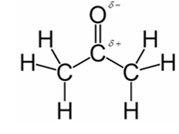
(e)
Interpretation:
The most polar bond of formaldehyde should be identified and polarity described with symbols
Concept Introduction:
Polarity of any molecule depends on electronegativity of atoms that forms covalent bonds. Depending upon the difference in electronegativity of atoms, polar or nonpolar molecule is determined. Polar molecule has electronegativity between 0.5 and 1.4 whereas in nonpolar molecule, it is less than 0.5.
Answer to Problem 10.49P
In formaldehyde, most polar bond is C=O with electronegativity difference of 1.0 and oxygen atom becomes partial negative charge atom whereas carbon becomes partial positive charge.

Explanation of Solution
Polar covalent bonds contains more atoms with high electronegativity and acquire more partial negative charge represented as delta minus
In formaldehyde, most polar bond is C=O with electronegativity difference of 1.0 and oxygen atom becomes partial negative charge atom whereas carbon becomes partial positive charge atom.
The bond C-H has electronegativity difference of 0.4 and it is a nonpolar bond.
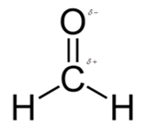
(f)
Interpretation:
The most polar bond of acetic acid should be identified and polarity described with symbols
Concept Introduction:
Polarity of any molecule depends on electronegativity of atoms that forms covalent bonds. Depending upon the difference in electronegativity of atoms, polar or nonpolar molecule is determined. Polar molecule has electronegativity between 0.5 and 1.4 whereas in nonpolar molecule, it is less than 0.5.
Answer to Problem 10.49P
In acetic acid, most polar bond is O-H with electronegativity difference of 1.4 and oxygen atom becomes partial negative charge atom whereas hydrogen becomes partial positive charge atom.
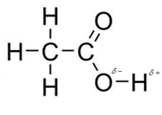
Explanation of Solution
Polar covalent bonds contains more atoms with high electronegativity and acquire more partial negative charge represented as delta minus
In acetic acid, most polar bond is O-H with electronegativity difference of 1.4 and oxygen atom becomes partial negative charge atom whereas hydrogen becomes partial positive charge atom.
The other bonds are C-C, C=O and C-H with electronegativity of 0, 1.0 and 0.4 but bond O-H has more electronegativity as compared to other bonds.
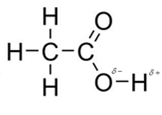
Want to see more full solutions like this?
Chapter 10 Solutions
Introduction to General, Organic and Biochemistry
- Draw the skeletal ("line") structure of 2-hydroxy-4-methylpentanal. Click and drag to start drawing a structure. Xarrow_forwardDetermine whether the following molecule is a hemiacetal, acetal, or neither and select the appropriate box below. Also, highlight the hemiacetal or acetal carbon if there is one. hemiacetal acetal Oneither OHarrow_forwardWhat is the missing reactant R in this organic reaction? ་ ་ ་ ་ ་ ་ ་ ་ ་ ་ +R H3O+ • Draw the structure of R in the drawing area below. N • Be sure to use wedge and dash bonds if it's necessary to draw one particular enantiomer. Click and drag to start drawing a structure.arrow_forward
- Write the systematic name of each organic molecule: H structure H OH OH H OH name ☐ OHarrow_forwardDetermine whether each of the following molecules is a hemiacetal, acetal, or neither and select the appropriate box in the table. CH3O OH OH OH hemiacetal acetal neither hemiacetal acetal neither Xarrow_forwardWhat is the missing reactant R in this organic reaction? N N དལ་ད་་ + R • Draw the structure of R in the drawing area below. • Be sure to use wedge and dash bonds if it's necessary to draw one particular enantiomer. Click and drag to start drawing a structure. ㄖˋarrow_forward
- Draw the condensed structure of 4-hydroxy-3-methylbutanal. Click anywhere to draw the first atom of your structure.arrow_forwardUsing the bond energy values, calculate the energy that must be supplied or is released upon the polymerization of 755 monomers. If energy must be supplied, provide a positive number; if energy is released, provide a negative number. Hint: Avogadro’s number is 6.02 × 1023.arrow_forward-AG|F=2E|V 3. Before proceeding with this problem you may want to glance at p. 466 of your textbook where various oxo-phosphorus derivatives and their oxidation states are summarized. Shown below are Latimer diagrams for phosphorus at pH values at 0 and 14: Acidic solution -0.93 +0.38 -0.51 -0.06 H3PO4 →H4P206 H3PO3 H3PO2 → P→ PH3 -0.28 -0.50 → -0.50 Basic solution 3-1.12 -1.57 -2.05 -0.89 PO HPO →→H2PO2 P PH3 -1.73 a) Under acidic conditions, H3PO4 can be reduced into H3PO3 directly (-0.28V), or via the formation and reduction of H4P2O6 (-0.93/+0.38V). Calculate the values of AG's for both processes; comment. (3 points) 0.5 PH, 0.0 -0.5- 2 3 9 3 -1.5 -2.0 Pa H,PO H,PO H,PO -3 -1 0 2 4 Oxidation state, N 2 b) Frost diagram for phosphorus under acidic conditions is shown. Identify possible disproportionation and comproportionation processes; write out chemical equations describing them. (2 points) c) Elemental phosphorus tends to disproportionate under basic conditions. Use data in…arrow_forward
- These two reactions appear to start with the same starting materials but result in different products. How do the chemicals know which product to form? Are both products formed, or is there some information missing that will direct them a particular way?arrow_forwardWhat would be the best choices for the missing reagents 1 and 3 in this synthesis? 1. PPh3 3 1 2 2. n-BuLi • Draw the missing reagents in the drawing area below. You can draw them in any arrangement you like. • Do not draw the missing reagent 2. If you draw 1 correctly, we'll know what it is. • Note: if one of your reagents needs to contain a halogen, use bromine. Explanation Check Click and drag to start drawing a structure. 2025 McGraw Hill LLC. All Rights Reserved. Terms of Use | Priva ×arrow_forwardPredict the products of this organic reaction: Explanation Check IN NaBH3CN H+ ? Click and drag to start drawing a structure. D 5 C +arrow_forward
 Introduction to General, Organic and BiochemistryChemistryISBN:9781285869759Author:Frederick A. Bettelheim, William H. Brown, Mary K. Campbell, Shawn O. Farrell, Omar TorresPublisher:Cengage Learning
Introduction to General, Organic and BiochemistryChemistryISBN:9781285869759Author:Frederick A. Bettelheim, William H. Brown, Mary K. Campbell, Shawn O. Farrell, Omar TorresPublisher:Cengage Learning Chemistry: The Molecular ScienceChemistryISBN:9781285199047Author:John W. Moore, Conrad L. StanitskiPublisher:Cengage Learning
Chemistry: The Molecular ScienceChemistryISBN:9781285199047Author:John W. Moore, Conrad L. StanitskiPublisher:Cengage Learning

